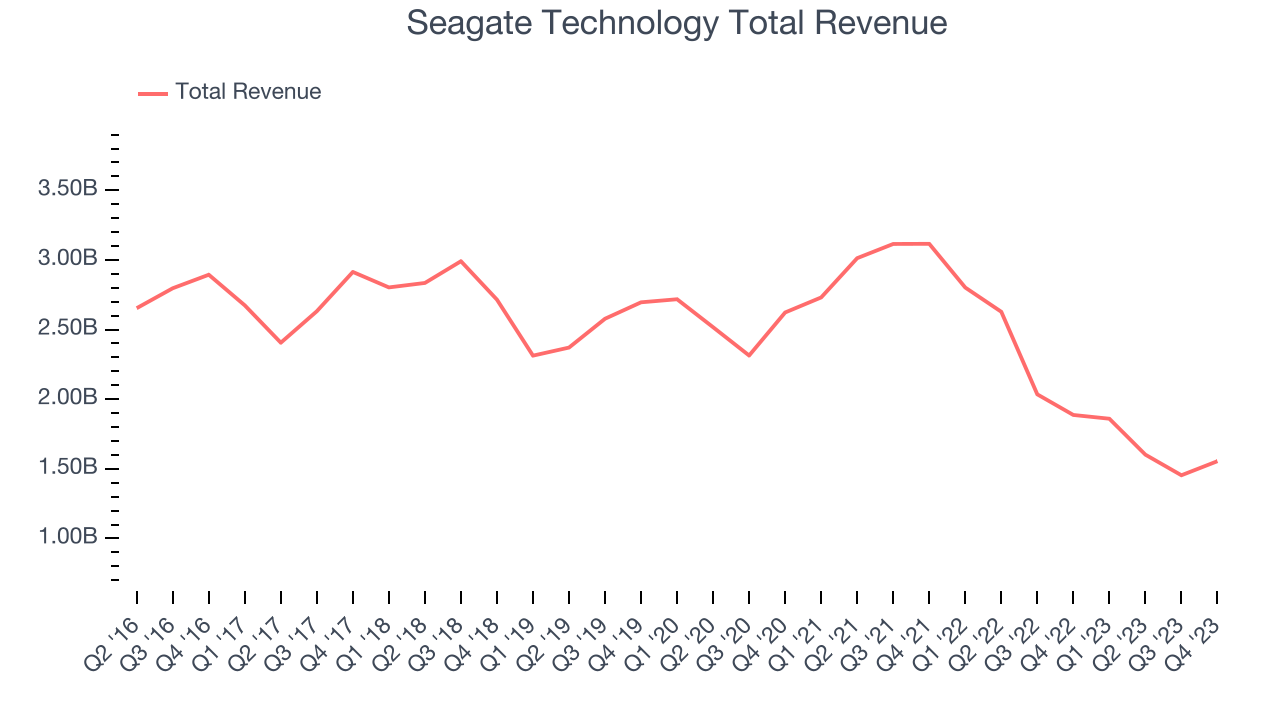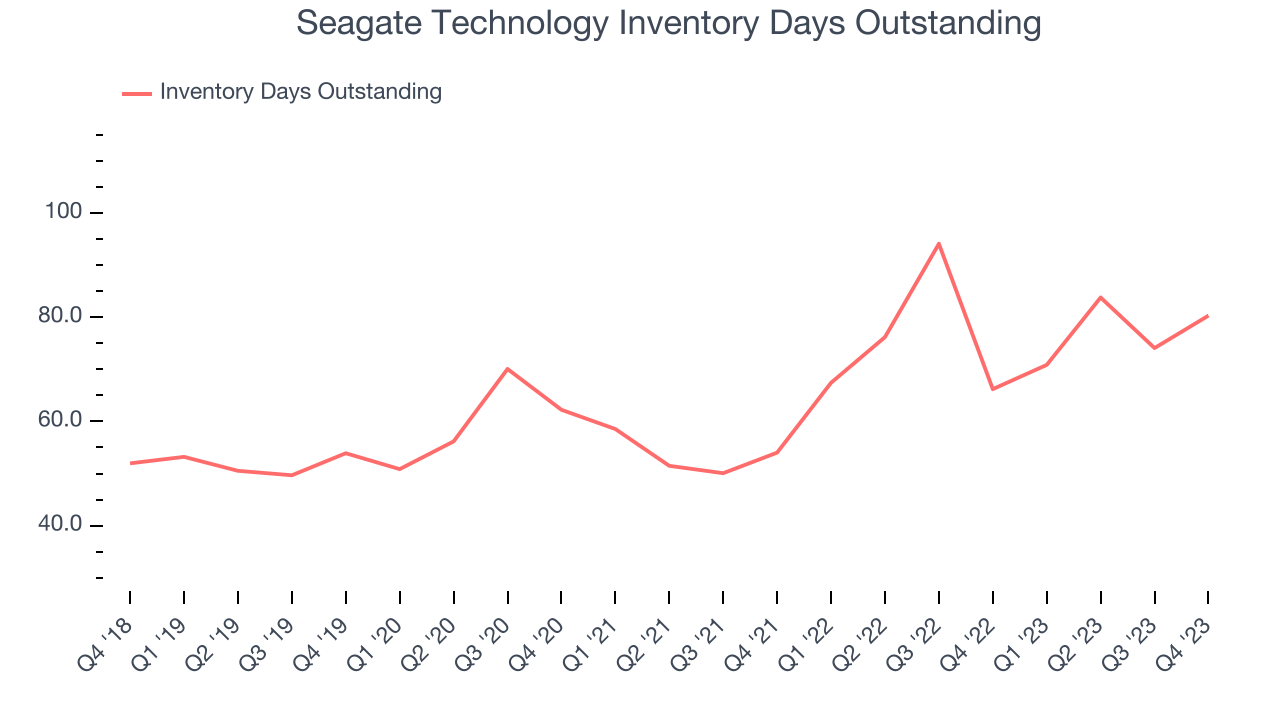Data storage manufacturer Seagate (NASDAQ:STX) reported results in line with analysts' expectations in Q2 FY2024, with revenue down 17.6% year on year to $1.56 billion. The company expects next quarter's revenue to be around $1.65 billion, in line with analysts' estimates. It made a non-GAAP profit of $0.12 per share, down from its profit of $0.16 per share in the same quarter last year.
Is now the time to buy Seagate Technology? Find out by accessing our full research report, it's free.
Seagate Technology (STX) Q2 FY2024 Highlights:
- Market Capitalization: $18.67 billion
- Revenue: $1.56 billion vs analyst estimates of $1.55 billion (small beat)
- EPS (non-GAAP): $0.12 vs analyst estimates of -$0.06 ($0.18 beat)
- Revenue Guidance for Q3 2024 is $1.65 billion at the midpoint, roughly in line with what analysts were expecting
- Free Cash Flow of $99 million, up 73.7% from the previous quarter
- Inventory Days Outstanding: 80, up from 74 in the previous quarter
- Gross Margin (GAAP): 23.3%, up from 13% in the same quarter last year
- Announced Quarterly Dividend of $0.70 per share
"Seagate delivered strong financial results in the December quarter, marked by 7% sequential revenue growth and non-GAAP EPS returning to profitability and exceeding the high end of our guidance range," said Dave Mosley, Seagate’s chief executive officer.
The developer of the original 5.25inch hard disk drive, Seagate (NASDAQ:STX) is a leading producer of data storage solutions, including hard drives and Solid State Drives (SSDs) used in PCs and data centers.
Memory Semiconductors
The rapid growth in data generation and the need to support increases in processing power for everything from consumer devices to data center servers are driving the demand for memory chips. From the content delivery networks and edge computing to the cloud, data storage is a key component underpinning the global technology architecture. On top of that, secular growth drivers like machine learning and the boom in media-rich digital content are further accelerating the need for storage. Like all semiconductor segments, memory makers are highly cyclical, driven by supply and demand imbalances and exposure to consumer product cycles.
Sales Growth
Seagate Technology's revenue has been declining over the last three years, dropping by 10.8% on average per year. This quarter, its revenue declined from $1.89 billion in the same quarter last year to $1.56 billion. Semiconductors are a cyclical industry, and long-term investors should be prepared for periods of high growth followed by periods of revenue contractions (which can sometimes offer opportune times to buy).

This was a slow quarter for the company as its revenue dropped 17.6% year on year, in line with analysts' estimates. This could mean that the current downcycle is deepening.
Seagate Technology looks like it's on the cusp of a rebound, as it's guiding to 12.7% year-on-year revenue growth for the next quarter. Analysts seem to agree as consesus estimates call for 17.9% growth over the next 12 months.
It’s not often you find a high-quality company at a significant discount to its historical P/E multiple, but that’s exactly what we found. Click here for your FREE report on this attractive Network Effect stock at a very silly price.
Product Demand & Outstanding Inventory
Days Inventory Outstanding (DIO) is an important metric for chipmakers, as it reflects a business' capital intensity and the cyclical nature of semiconductor supply and demand. In a tight supply environment, inventories tend to be stable, allowing chipmakers to exert pricing power. Steadily increasing DIO can be a warning sign that demand is weak, and if inventories continue to rise, the company may have to downsize production.

This quarter, Seagate Technology's DIO came in at 80, which is 17 days above its five-year average, suggesting that the company's inventory has grown to higher levels than we've seen in the past.
Key Takeaways from Seagate Technology's Q2 Results
We were impressed by Seagate Technology's strong gross margin improvement this quarter. We were also glad its EPS and free cash flow blew past Wall Street's estimates. On the other hand, its inventory levels materially increased. In terms of product developments, the company launched its Mozaic platform, which marked an inflection point in its mass capacity storage capabilities. The Board also declared a $0.70 per share quarterly dividend payable on April 4, 2024 to shareholders of record as of the close of business on March 21, 2024. This represents a 3% dividend yield based on Seagate's current share price. Overall, we think this was a strong quarter that should satisfy shareholders. The market was likely expecting more, however, and the stock is down 4.3% after reporting, trading at $85.31 per share.
Seagate Technology may have had a good quarter, but does that mean you should invest right now? When making that decision, it's important to consider its valuation, business qualities, as well as what has happened in the latest quarter. We cover that in our actionable full research report which you can read here, it's free.
One way to find opportunities in the market is to watch for generational shifts in the economy. Almost every company is slowly finding itself becoming a technology company and facing cybersecurity risks and as a result, the demand for cloud-native cybersecurity is skyrocketing. This company is leading a massive technological shift in the industry and with revenue growth of 50% year on year and best-in-class SaaS metrics it should definitely be on your radar.
